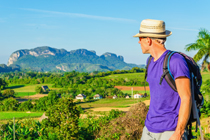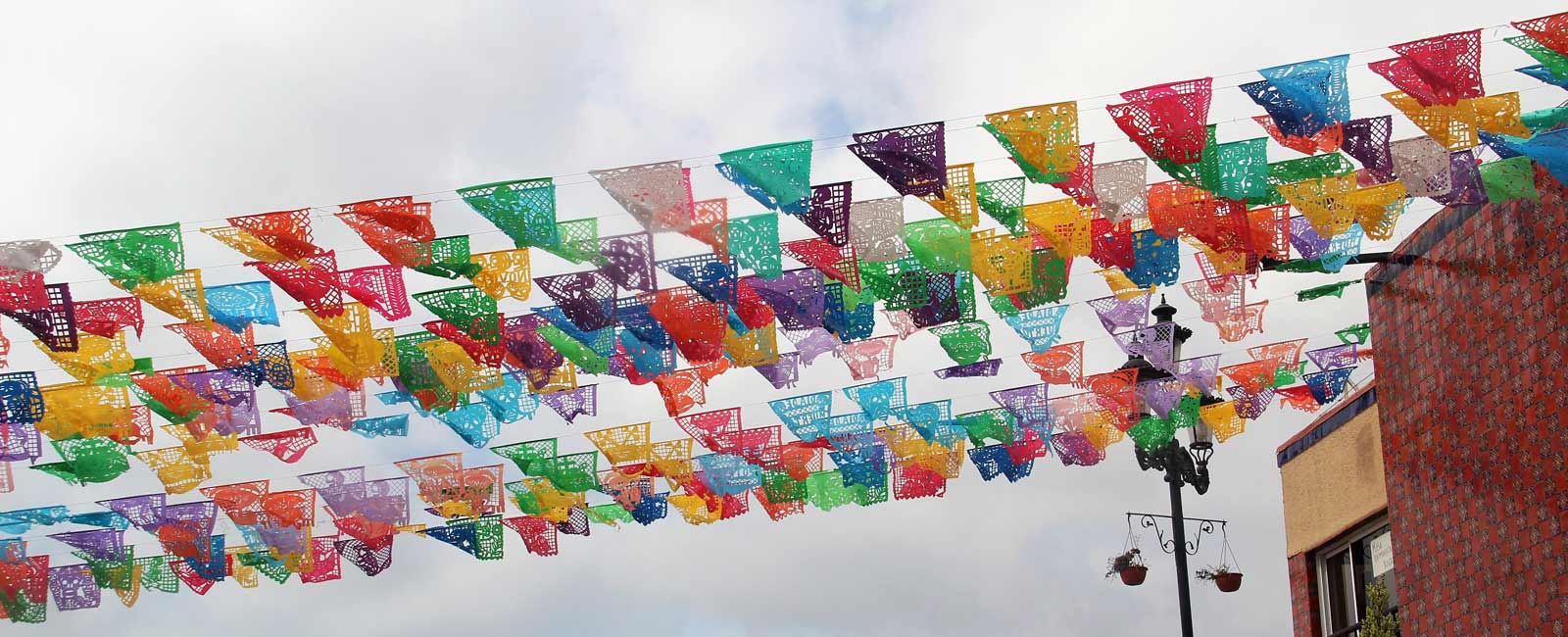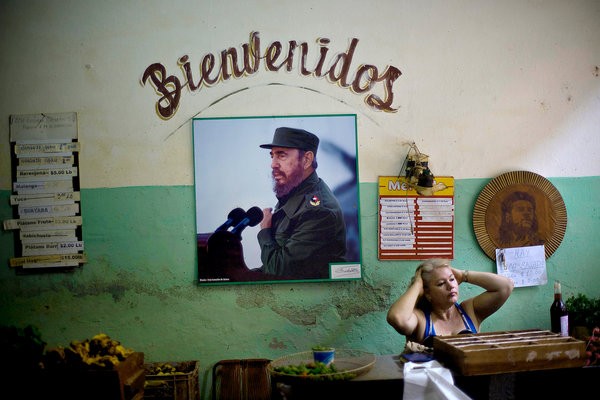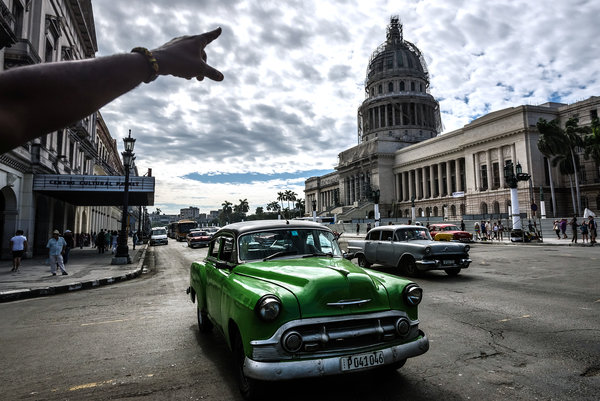
New Rules for Travel to Cuba, a Destination Already in Transition
A state-run food market in Havana. The Treasury Department announced new, more flexible, regulations on Thursday that will make travel to Cuba easier for Americans. Related article. Credit Ramon Espinosa/Associated Press
Estelle Grush sliced cucumber and guava in the busy kitchen one recent evening at Café Laurent, a small, privately owned restaurant in a 1950s penthouse a few blocks from the city’s sweeping seafront.
As she chopped, Ms. Grush, who was visiting Havana from Los Angeles as part of an organized tour, chatted with the chef, Victor Ramón Salgado. She took notes as he prepared rich rounds of flan made with cream cheese, his spin on the popular Spanish dish, and told her how to make caramel. They talked about life in Cuba and in Atlantic City, where Mr. Salgado worked for a couple of years.
“It was a unique experience,” said Ms. Grush, 59, who spent four hours helping at the restaurant, adding, “It was great not just to cook with him, but to be able to talk with people from the country.”
A stint in a Havana restaurant kitchen is hardly a typical element of a Caribbean holiday. As Americans prepare to visit Cuba under new, more flexible regulations announced by the Treasury Department on Thursday, however, American officials still expect them to get a close view of life on the island rather than sit poolside with a margarita.
Havana. Under the new rules, Americans who qualify to travel will not have to apply for a license before they do so – a process that, in the past, could take weeks. Credit Meridith Kohut for The New York Times
Under the economic embargo, Americans are permitted to travel to Cuba only for specific purposes, which fall into 12 categories and include religious, educational, cultural, professional, journalistic or humanitarian activities. Many Americans visit Cuba on educational exchange programs, known as “people-to-people” tours, whose tight itineraries consist of back-to-back meetings with Cubans — from architects to chefs to farmers — and include minimal free time.
Under the new rules, which will take effect on Friday as part of a deal to restore diplomatic relations between the United States and Cuba, Americans who qualify to travel under one of 12 categories will no longer have to apply for a license before they travel — a process that, in the past, could take weeks or months. And travelers will be permitted to use credit cards and spend money while in the country and bring back up to $400 in souvenirs, including up to $100 in alcohol or tobacco. What is not clear, say travel experts, is how American authorities plan to monitor what its citizens do when they get to Cuba. “What we don’t know is, ‘What is the border of these regulations?’ “ said Bob Guild, vice president of Marazul Charters, which has provided travel services to Cuba for 35 years. “Is anyone going to be vetting travel anymore?”
More flexible travel rules introduced in 2011 have already increased American travel to the island. About 100,000 Americans visit each year, while Cubans living in the United States make about 400,000 visits to see family. Those numbers could rise significantly under the new regulations, travel agents and tour leaders said.
Mr. Guild said “all hell broke loose” after an announcement on Dec. 17 saying that travel rules would loosen.
“I get hundreds of emails every day from people saying, Can I go next weekend?” Mr. Guild said by telephone this week from Miami. Anticipating high demand for hotels, he said, more than 50 travel organizations that have licenses from the Treasury Department to bring groups to Cuba asked him to block-book rooms for them through 2016.
That is another question: As keen as the Cuban government is to receive tourists — about three million came last year — it may not be able to handle a sudden increase in visits from America, which is the source of about half a million visits a year (80 percent of these are Cuban-Americans). The Communist government may also be wary of having a flood of Americans discussing capitalism and democracy with its people, political analysts said.
“If travel picks up three, four, fivefold, what is the Cuban response going to be?” said Collin Laverty, director of Cuba Educational Travel, which organized Ms. Grush’s trip.
“Are they going to have enough hotel rooms?” he added. “Are they going to have the infrastructure to deal with it? Will they issue all the visas?
Travel representatives predicted that Americans would continue to use people-to-people trips to visit Cuba because everything is arranged for them and if their tour is organized by someone knowledgeable, they experience things they might not see by themselves. A large proportion of those Americans who currently visit Cuba do so on people-to-people trips, they said.
Ms. Grush met Mr. Salgado, the chef, during a group cookery class at the restaurant and asked if she could return in the evening. Mr. Salgado said he hoped others who came for cookery classes would ask to do the same.
“I would love to do it again,” he said.
Mr. Laverty, though, believes Americans who dislike or cannot afford group travel will begin to visit independently because traveling under one of the 12 existing categories will no longer involve difficult and time-consuming paperwork.
“I think there’s going to be a shift overnight from group travel to individual travel and from elite travel to budget travel,” said Mr. Laverty. The looser rules would make it “easier and more affordable to visit Cuba in a small group,” he added.
People-to-people trips tend to attract wealthy, late-middle-aged Americans who enjoy the comforts of four-star hotels after days spent in lectures or shuffling through artists’ studios and organic farms. Americans are popular among guides, who can earn hundreds of dollars in tips from one group.
Ms. Grush’s eight-day trip, which included return flights from Miami to Havana, a trip to Pinar del Rio, a tobacco-growing province west of Havana, activities, some meals, and accommodation at the Iberostar Parque Central Hotel in Old Havana, cost $3,850 per person.
Individual travel — particularly if commercial flights open between Cuba and the United States — could be much cheaper. A meal in the best privately run restaurants costs about $35. A typical bed-and-breakfast in Havana charges $35 to $50 a night.
Given the lack of hotel rooms, bed-and-breakfasts could be in demand, said Tom Miller, author of “Trading With the Enemy: A Yankee Travels Through Castro’s Cuba.”
“The hotel room situation will be the first crisis,” he said, adding, “There are only half a dozen really high-end hotels and, in the midrange places, there are invariably problems: The window won’t shut, the sink isn’t working.”
Mr. Miller, who took a group of Americans to Cuba for a literary tour in January, said solo travelers could visit remote areas that see few tourists.
“If people go in ones or twos and hitchhike, and they are picked up by people along the highway, I think they’ll learn more,” he said.
Even those who are not up for hitchhiking could use almendrones, the clattering American jalopies that operate as communal taxis in Havana, said travel experts. They could venture beyond the prettified district of Old Havana, where tourists are herded, and into neighborhoods where Cubans rarely see tourists.
Visitors could also go to music venues like El Sauce, an outdoor stage surrounded by royal palm trees in a green suburb of Havana, and mingle with young Cubans, they said.
leksas Juskys, 35, a retired F-16 Air Force pilot who visited Cuba in January as part of his dual masters course at the University of Pennsylvania, said he would like to come back on his own.
“When you’re in a group you can’t walk down the street and talk to people like you would if it was just you,” said Mr. Juskys, who was crammed, along with about 30 fellow students, into the tiny apartment of a Cuban hip-hop band, Obsesión, for a talk on racial inequality.
Even so, Mr. Juskys, who also received an explanation of the Cuban rationing system at a bleak bodega in the poor Havana neighborhood of Regla, said the group was getting “the kind of access I never would have expected.”
There were signs, too, that information was flowing both ways. During the talk on race, Alexey Rodríguez, 42, and Magia López, 40, the band members, asked for advice about establishing a community center — perhaps a coy bid for financial help — and about their impressions.
“What’s the image you have of Cuba?” Mr. Rodríguez asked them. “How are relations between the countries going to change?”
Alex Rodríguez, 50, an entrepreneur from Los Angeles who was with his family on the same trip as Ms. Grush, said that Mario Pelegrín, a folk artist who runs community projects in Pinar del Rio, had offered his 21-year-old daughter Mayela, a student at University of California, Berkeley, space to build a sculpture in his lush garden.
Mr. Rodríguez, who was admiring the 17th- and 18th-century buildings of the restored Plaza Vieja in Old Havana on a recent morning, said he hoped to return with Mayela and had, separately, emailed California legislators and business people to suggest organizing a delegation.
While he was an evangelist for American travel to Cuba, he hoped mass tourism was not in the cards.
“I’m worried about them opening the flood gates,” he said. “Then everyone and their mother will want to come.”
Update
By VICTORIA BURNETT


